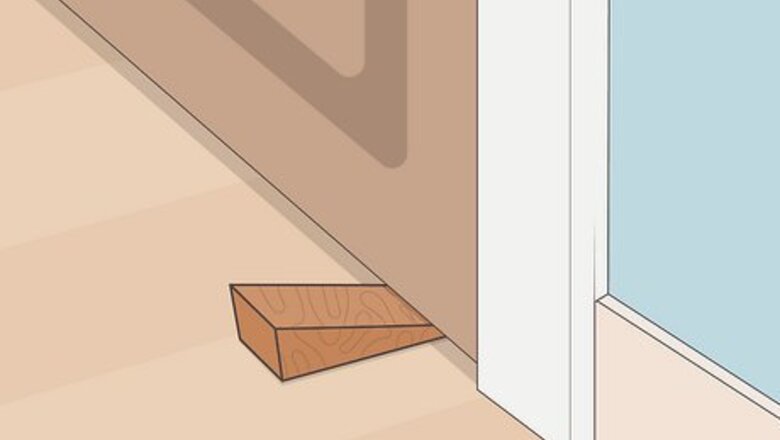
views
Use a doorstop.

Jam the door shut with a wooden, plastic, or rubber wedge. Door wedges or stops are often used to keep doors open, but they can also keep doors shut. Close your door and stick the pointy end of the wedge in the gap between the floor and the door. Kick it in until it’s immovable. Alternatively, make a doorstop out of household items like a shoe or cardboard box. This method is a temporary fix for inward-swinging doors with a gap between the door and the floor.
Wedge a chair under the door knob.
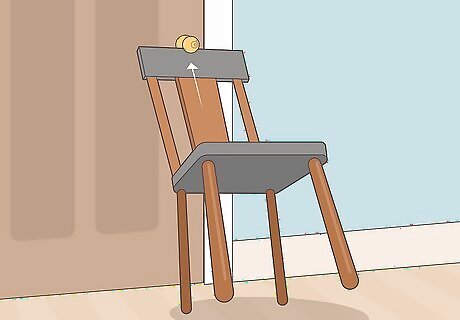
Barricading the door with a chair can keep it closed. Take a chair that’s a little higher than your door knob and position it under the knob at a 45-degree angle. Wedge the backrest underneath the knob—the front legs will be off the ground because of this. This locking method works on inward-swinging doors and is a temporary fix as the chair could slide out from under the handle.
Bend a fork into the door latch.
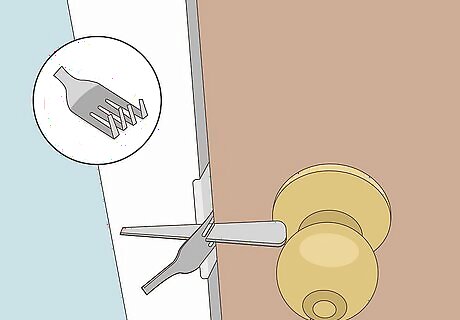
Make your own lock out of a fork for a temporary fix. Use pliers to bend ¼ of a fork’s prongs up at a 90-degree angle. Cut the fork's handle off with wire cutters, leaving about 1 inch (2.5 cm) on the prong end. Open the door and put the bent prongs in the door latch. Close the door on the fork with the end sticking out. Insert the fork’s handle through the prongs horizontally, with half of it across the door and the other half over the door frame. Place a piece of cardboard or a towel on the side of the handle across the door frame to keep the door from wiggling. This locking method is portable, easily made, and works on inward- and outward-swinging doors with a latch.
Place furniture in front of the door.
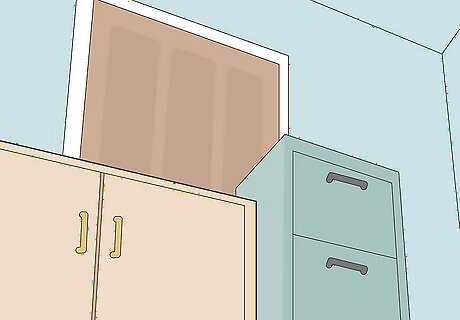
Build a barricade out of nearby furniture to keep someone out. Place chairs, desks, beds, cabinets, or bookshelves in front of an inward-swinging door. This will ensure that the door can’t swing open. Use whatever is around that’s heavy to block the door. The best items are those that take up half of the door. This locking method is temporary and not foolproof.
Tighten a belt around the door hinge.
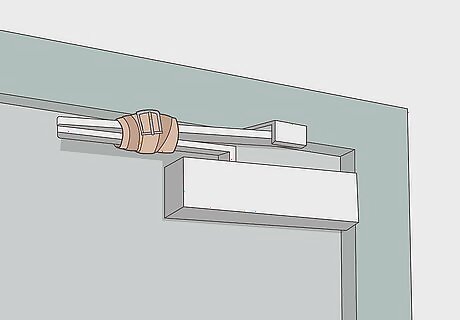
Use a belt or rope to lock a commercial building door. Many office, hotel, and school doors have an automatic hinge at the top. Barricade one of these doors by wrapping and tying a belt around it. Guide the end of the belt through the hinge arm bolted to the door frame. Then, tightly wrap the belt around the rest of the hinge. Weave the belt through the center of the loop to keep it in place. Ropes and purse straps can also be effective. This solution is temporary and only works on inward-swinging doors with a hinge.
Remove the door knob.
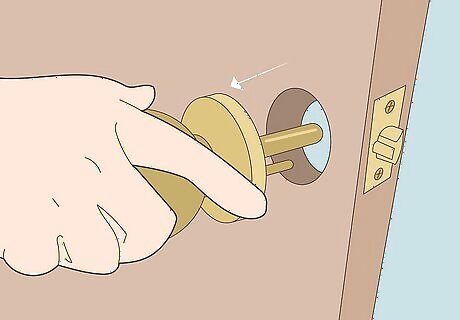
Take the knob or handle off the door from the outside. If you have no other way to lock your door, consider removing the door knob entirely. Use a screwdriver to unscrew the plate of the knob, and then pull the knob off the door. This works on inward- and outward-swinging doors but isn’t a permanent solution. Although this method prevents people from getting into the room, it also prevents you from getting out. Some door knobs and handles have hidden screws attaching them to the door that may be harder to remove in a pinch.
Purchase a portable door lock.
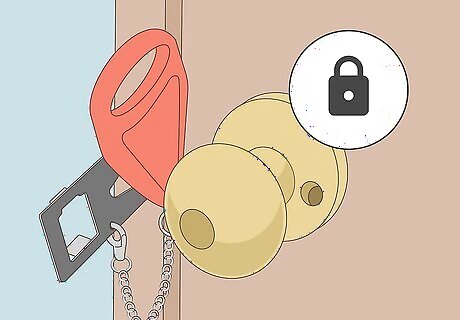
Buy a lock that you can bring and use anywhere. There are many types of portable door locks on the market, but the majority consist of a metal plate and chain with a locking mechanism. Generally, the metal plate is placed in the door’s latch, and the locking mechanism is inserted in a grove on the plate. Follow the product’s instructions for proper installation. This solution can be temporary or permanent for inward- and outward-swinging doors, depending on your situation. For example, use it for security while traveling or at home as a second barrier on top of a lockable door.
Try a door security bar.
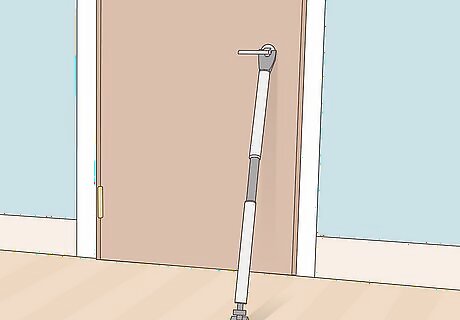
Wedge a sturdy pole under the knob to secure the door closed. Door jammers or portable security bars are a one-time cost for your peace of mind. These devices can be found at some convenience stores or online. All you have to do to install these is slide the handle slot under the door knob at a 45-degree angle. Adjust the pole until the base is resting flat on the floor. Push the base toward the door until the pole is standing on its own. This portable lock device can be used on inward-swinging and sliding glass doors. For a sliding glass door, remove the door handle slot and wedge the bar between the door frame.
Invest in a door barricade bar.
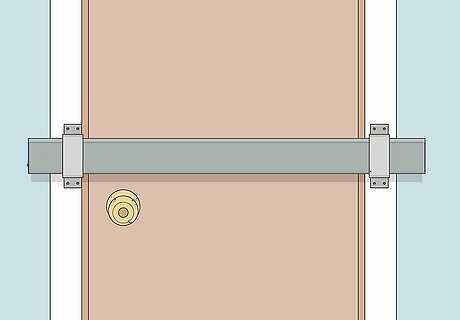
A wooden or metal barricade bar is a great option if you feel unsafe. These permanent locking devices are easy to install and provide extreme security. Screw the lock anchors on either side of the door frame above the door handle. Make sure these pieces are parallel and level with each other. Slip the metal barricade piece into the anchor slots to lock the door. Make your own security bar by screwing brackets on either side of the door frame and setting a 2x4 across them. This works best on inward-swinging doors and will prevent a door from being knocked down.
Install a floor barricade.
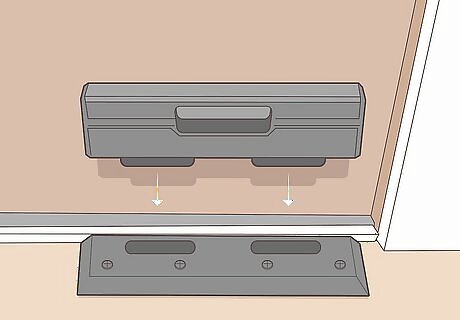
Secure your door with a permanent door stopper. Floor barricades or braces are sturdy metal devices that you attach to the floor on the inside of a door. The metal plate screws into the floor beneath the door, and a block-like door stopper fits inside it. When it comes time to lock your door, close it and place the block stopper inside the plate. Professional installation is required for this lock if you have cement, tile, or stone flooring or are inexperienced with a drill. This permanent locking device works best on inward-swinging doors as you want to be the one removing and placing the block. Most floor barricade owners use this device as a secondary lock for additional security on top of a regular lock.




















Comments
0 comment